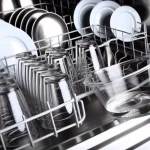The three best techniques for dishwasher installation and maintenance include selecting an ideal location, preparing properly for installation, and guaranteeing routine maintenance. To start, position the dishwasher close to the sink to minimize plumbing complexity and confirm it has enough ventilation space. Next, during installation, make sure to shut off water and power supplies, securely connect the water supply line without kinks, and double-check drain connections to prevent backflows. Regular maintenance practices such as cleaning the filter monthly, checking door seals, and inspecting hoses for wear greatly extend the appliance's life and efficiency. Addressing these aspects systematically allows users to maximize the potential benefits and reduces disruptions. Further exploration offers added insights into achieving even greater appliance efficiency.
Selecting the Optimal Location
Selecting the ideal location for your dishwasher is a essential first step in the installation process. As you decide, consider the kitchen layout and plumbing access, two important factors that will greatly impact the efficiency and functionality of your appliance.
The kitchen layout dictates the spatial dynamics; the dishwasher should integrate seamlessly without disrupting the flow or accessibility of kitchen activities. It's advisable to place it near the sink to simplify plumbing connections and guarantee easy loading of dishes.
Furthermore, easy plumbing access is critical. Most dishwashers require a water supply and drain, so proximity to existing plumbing lines reduces installation complexity and costs.
It's also worth noting that the placement should support future maintenance without requiring major kitchen disruptions.
Be wary of corners and tight spaces that might hinder the opening of the dishwasher door or the pull-out of racks. Additionally, verify there is enough space for ventilation to prevent overheating and prolong the lifespan of the unit.
Proper Installation Steps
Upon determining the ideal location for your dishwasher, the next essential step is to confirm proper installation to maximize its efficiency and longevity.
Begin by verifying that both the water supply and power connections are safely turned off before proceeding. This is important to prevent any accidental water flow or electrical shocks during the setup process.
Firstly, connect the dishwasher's water supply line to the home's water supply valve. It's imperative to use a wrench to tighten this connection securely to avoid any potential leaks, which can cause significant water damage over time.
Make sure the water supply line is not kinked or bent, as this could restrict water flow to the dishwasher, affecting its performance.
Next, the drain connection must be properly configured. Attach the dishwasher's drain hose to the sink's drain pipe or garbage disposal unit. This should be done using clamps to guarantee a tight fit and to prevent the backflow of dirty water into the dishwasher, which can be a health hazard.
Once these connections are made, carefully slide the dishwasher into its designated space, making sure not to disturb the newly made connections.
Check and double-check all fittings and hoses for signs of stress or leakage before finally turning the water supply and power back on.
Routine Maintenance Practices
Regular maintenance of your dishwasher is essential to guarantee its ideal performance and extend its lifespan. To keep your appliance in top condition, several routine practices should be regularly employed.
Firstly, filter cleaning is significant. Over time, food particles and debris accumulate in the dishwasher filter. If not cleaned regularly, this can lead to reduced efficiency and potentially costly repairs. It is recommended to clean the filter every month, depending on usage. Simply remove the filter, rinse it under running water, and gently scrub off the debris with a soft brush.
Additionally, spray arm maintenance guarantees that water is evenly distributed during cycles. Check the spray arms for clogs or debris and clean them with a small pin or toothpick to remove any obstructions.
Door seal inspection is another essential practice. Wipe the seals with a damp cloth to prevent food particles from hardening, which could lead to leaks.
Similarly, hose checks are important to avoid water damage. Inspect the hoses periodically for any signs of wear or leakage.
Lastly, addressing noise reduction can enhance the operational quietness of your dishwasher. Confirm that all internal parts are securely fastened and that the appliance is level to minimize vibrations and noise during operation.
These simple steps will help maintain the efficiency and longevity of your dishwasher.
Frequently Asked Questions
Can I Install a Dishwasher Without Professional Help?
DIY dishwasher installation is feasible, but awareness of common installation mistakes is essential. Make sure you understand plumbing and electrical connections to prevent issues such as leaks or electrical faults for a successful setup.
What Types of Dishwashers Are Most Energy-Efficient?
Energy-efficient dishwashers are the quiet sentinels of conservation. Models with ENERGY STAR ratings lead the pack, featuring eco-friendly features that reduce water usage and optimize energy consumption, making them top choices for energy-saving performance.
How Often Should Dishwasher Filters Be Replaced?
Dishwasher filter cleaning is essential for peak performance. Replacement frequency varies by model and usage, but generally, filters should be checked monthly and replaced annually to maintain efficiency and prevent clogs and malfunctions.
Can You Use Regular Dish Soap in a Dishwasher?
Using regular dish soap in a dishwasher is not advisable as it can create excessive suds and leaks. Opt for dish soap alternatives specifically formulated for dishwasher use to guarantee peak cleaning performance.
What Should I Do if My Dishwasher Starts Leaking?
If your dishwasher starts leaking, immediately stop its use to prevent water damage. Employ leak detection methods to identify the source, then seek professional repair or consult the manufacturer's guidelines for specific troubleshooting steps.



